ABIT Siluro GF4 Ti 4200 64 MBytes
Prolink PixelView GeForce4 Ti 4200 128 MBytes
Palit Daytona GeForce4 Ti 4200 128 MBytes
and Gainward PowerPack GeForce4 Ti 4200 64
|

Contents
- Peculiarities of the NVIDIA GeForce4 Ti 4200
based video cards from ABIT, Prolink, Palit and Gainward
- Information on performance of video cards
of the GeForce4 Ti 4200 class
Today we continue examining new solutions of video cards based
on the super-popular GeForce4 Ti 4200. Or I'd rather say that we finish doing
it because it seems that the flow of such cards has become very thin. Maybe we
will get one-two more such cards. Besides, RADEON 8500 card reviews are just around
the corner.
The GeForce4 Ti 4200 was much spoken about already. Just want
to say that it is the same GeForce4 Ti only working at a lower frequency. Besides,
there are two types of Ti 4200 based cards: with 64 and with 128 MBytes memory.
As usual, first of all take a look at the list of the already
reviewed cards based on the GeForce4 Ti.
Theoretical materials and reviews of video cards which concern
functional properties of the NVIDIA GeForce4 Ti GPU
- NVIDIA GeForce4 Ti review
- MSI GF4Ti4600 on NVIDIA
GeForce4 Ti - concerns anisotropic filtering in the 3DMark2001 SE, and new
Advanced Pixel Shader Test from this packet.
- Leadtek WinFast GeForce4
Ti 4600 on NVIDIA GeForce4 Ti 4600 - tests based on the Vulpine GLMark with
anisotropy enabled.
- Gainward PowerPack GeForce4
Ultra/700XP and Ultra/750XP Golden Sample on NVIDIA GeForce4 Ti 4400/4600
- Codecult Code Creatures and Novalogic Comanche4 Benchmark.
- Chaintech A-GF61 SE
on NVIDIA GeForce4 Ti 4600 - dependence of the performance on a CPU speed
(AMD Athlon 750, 1000 MHz, Athlon XP 1250, 1666 MHz; in Serious Sam II, Return
to Castle Wolfenstein).
- Creative 3D Blaster GeForce4
Ti 4400 on NVIDIA GeForce4 Ti 4400 - dependence of the performance on a CPU
speed (Intel Pentium III 1000, Pentium 4 2000, 2200 MHz; in Serious Sam II, Return
to Castle Wolfenstein).
- ASUS V8440 and V8460 on
NVIDIA GeForce4 Ti 4400 and 4600 - dependence of the performance on a CPU
speed (Intel Pentium III 1000, Pentium 4 2000, 2200 MHz, AMD Athlon 750, 1000
MHz, Athlon XP 1250, 1666 MHz; in 3DMark2001 SE).
- ABIT Siluro GF4 Ti on
NVIDIA GeForce4 Ti 4400 - AA operation in the 3DMark2001 SE.
- Palit Daytona GeForce4
Ti 4600 - operation of anisotropy on different platforms based on the 3DMark2001
SE (Game1, Game2).
- Joytech Apollo Bloody
Monster II GeForce4 Ti 4600 - examination of anisotropy on different platforms
on the 3DMark2001 SE (Game3, Game4).
- SUMA Platinum GeForce4
Ti 4400 DVI and GeForce4 Ti 4600 SE - examination of anti-aliasing on different
platforms in 3DMark2001 SE (Game1, Game2).
- Triplex Millennium Silver
GeForce Ti 4600 - examination of anti-aliasing on different platforms in 3DMark2001
SE (Game3, Game4).
- Leadtek WinFast A250LE
64 MBytes and Gainward Powerpack Ultra/650XP 128 MBytes on NVIDIA GeForce4 Ti
4200
- SUMA
Platinum GeForce4 Ti 4200 64 MBytes, GeForce4 Ti 4200 SE 64 MBytes, GeForce4 Ti
4200 SE 128 MBytes - examination of anisotropy in Return to Castle Wolfenstein,
Serious Sam: The Second Encounter.
- SUMA
Platinum GeForce4 Ti 4200 64 MBytes, 4200SE 64 MBytes and 4200SE 128 MBytes
- examination of anisotropy in 3DMark2001 SE, RtCW, Serious Sam: TSE.
- Sparkle
GeForce4 Ti 4400 and GeForce4 Ti 4600 cards.
So, as you understand, today we are dealing with four graphics
solutions produced by ABIT, Prolink, Palit and Gainward. The Ti 4200 cards from
Gainward was already examined some
time ago, but that time it was a card with 128 MBytes of memory, and today we
have a 64 MBytes model.
Cards
| ABIT Siluro GF4 Ti 4200 64 MBytes |
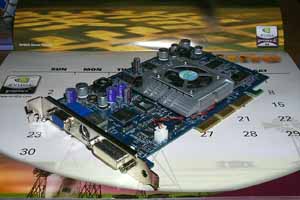
|
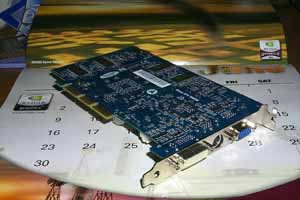
|
| Prolink PixelView GeForce4 Ti 4200 128 MBytes |
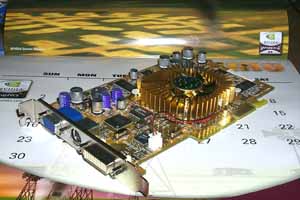
|
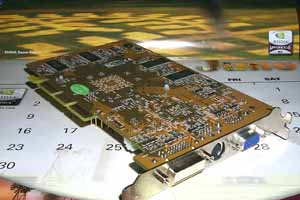
|
| Palit Daytona GeForce4 Ti 4200 128 MBytes |
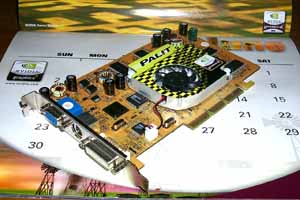
|
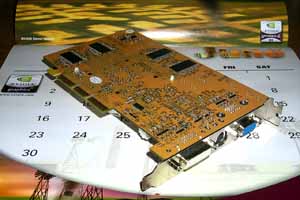
|
| Gainward Powerpack Ultra/650 XP 64 MBytes |
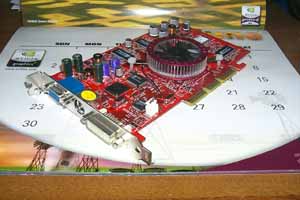
|
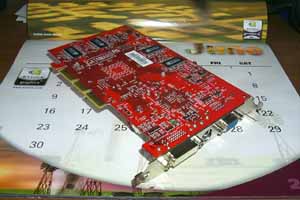
|
| ABIT Siluro GF4 Ti 4200 64 MBytes |
The card has an AGP x2/x4 interface, 64 MBytes DDR
SDRAM located in 8 chips on both sides of the PCB.
This card comes with Hynex memory modules of 4ns access time which corresponds
250 (500) MHz, but the memory works at 256 (513) MHz. The GPU operates at 250
MHz which is a rated mode for the Ti 4200. |
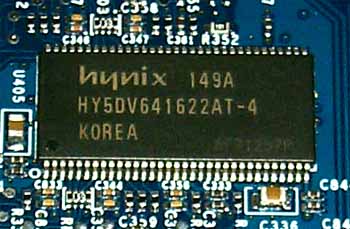
|
| Prolink PixelView GeForce4 Ti 4200 128 MBytes |
The card has an AGP x2/x4 interface, 128 MBytes DDR
SDRAM located in 8 chips on both sides of the PCB.
This card comes with Samsung memory modules of 4ns access time which corresponds
250 (500) MHz, but the memory works at 230 (460) MHz. The GPU operates at 250
MHz. |
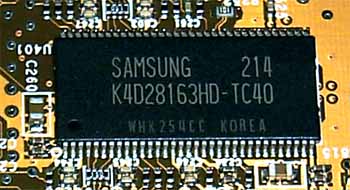
|
| Palit Daytona GeForce4 Ti 4200 128 MBytes |
The card has an AGP x2/x4 interface, 128 MBytes DDR
SDRAM located in 8 chips on both sides of the PCB.
This card comes with Samsung memory modules of 4ns access time which corresponds
250 (500) MHz, but the memory works at 265 (530) MHz. The GPU operates at 250
MHz. |
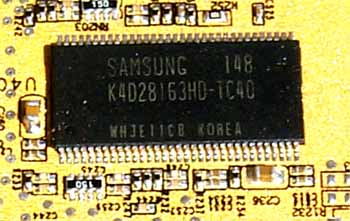
|
| Gainward Powerpack Ultra/650 XP 64 MBytes |
The card has an AGP x2/x4 interface, 64 MBytes DDR
SDRAM located in 8 chips on both sides of the PCB.
This card comes with EtronTech memory modules of 3.5ns access time which corresponds
285 (570) MHz, but the memory works at 256 (513) MHz. The GPU operates at 250
MHz. |
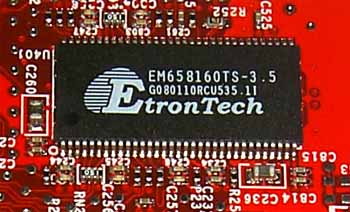
|
| Comparison with the reference design, front view |
| ABIT Siluro GF4 Ti 4200 64 MBytes |
Reference card NVIDIA GeForce4 Ti 4200 |
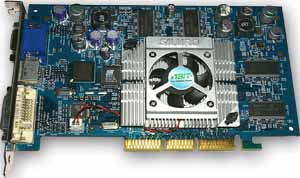
|
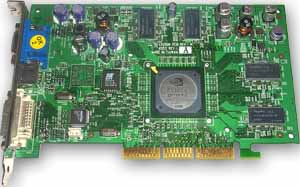
|
| Prolink PixelView GeForce4 Ti 4200 128 MBytes |
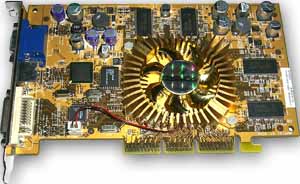
|
| Palit Daytona GeForce4 Ti 4200 128 MBytes |
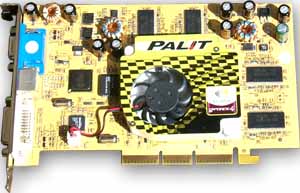
|
| Gainward Powerpack Ultra/650 XP 64 MBytes |
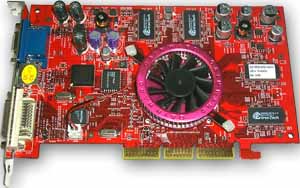
|
| Comparison with the reference design, back view |
| ABIT Siluro GF4 Ti 4200 64 MBytes |
Reference card NVIDIA GeForce4 Ti 4200 |
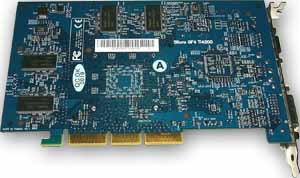
|
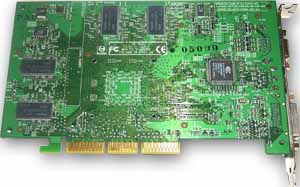
|
| Prolink PixelView GeForce4 Ti 4200 128 MBytes |
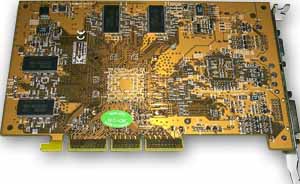
|
| Palit Daytona GeForce4 Ti 4200 128 MBytes |
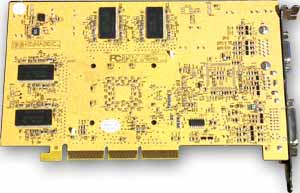
|
| Gainward Powerpack Ultra/650 XP 64 MBytes |
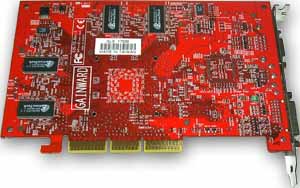
|
None of cards deviates from the reference design. Note that
for some time now all 64 MBytes cards have been working at a frequency higher
by 6 (13) MHz than it was before (probably due to the new BIOS from NVIDIA, because
all the models in question come with the reference BIOS). That is why all video
cards based on the GeForce4 Ti 4200 with 64 MBytes memory have frequencies of
250/256 (513) MHz.
As far as the 128 MBytes cards are concerned, we have come
across an official overclocking in case of the Prolink and Palit cards. Palit
has also increased a memory speed (for the 4ns memory the rated frequency is 250
MHz, but they have lifted it up to 265 MHz). Besides, both 64 MBytes and 128 MBytes
cards are based on a single design. The differences are only in the memory chips'
size.
Now let's look at peculiarities of each card. As you can see,
apart from the memory size they differ in the PCB color and in design of their
coolers. It is the first time we come across a golden color which is used by Palit
for its card. The Gainward card is traditionally red, and the Prolink is traditionally
yellow. Only ABIT ships an unusually sky-blue card.
Below are the cooling devices:
| ABIT Siluro GF4 Ti 4200 64 MBytes |
| For 1.5 years already ABIT has been equipping its cards with
the same cooler. Even the fact that on GeForce4 Ti based cards mounting holes
are shifted further from the chip (because the NVIDIA recommended heatsink is
quite big) didn't make the company change the cooler. |
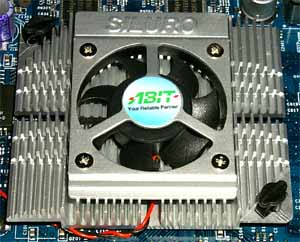
|
| Prolink PixelView GeForce4 Ti 4200 128 MBytes |
| The cooler installed on this card is a very beautiful
solution. Some time ago we saw something similar on the Chaintech models. Note
that all such beautiful heatsinks are produced by the well-known companies ThermalTake
or Titan. |
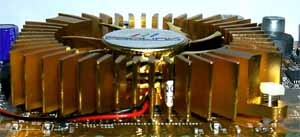
|
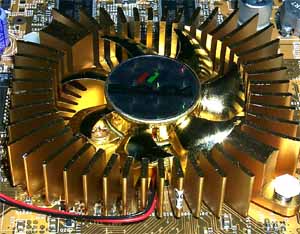
|
| Palit Daytona GeForce4 Ti 4200 128 MBytes |
| Palit didn't look for anything original and used
a reference cooler. Besides, it is the first time Palit shows its name on the
video card! Let it be just a cooler, but now we know definitely that we have a
Palit's solution. |
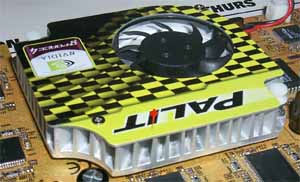
|
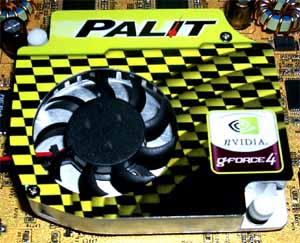
|
| Gainward Powerpack Ultra/650 XP 64 MBytes |
| Gainward uses a typical cooling device which consists
of a round flat platform with numerous vertical fins. Above, it has a circle with
the company's name. |
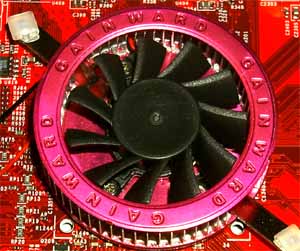
|
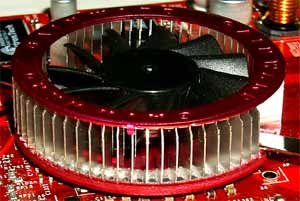
|
Under the coolers we have discovered the GPU - GeForce4 Ti 4200:
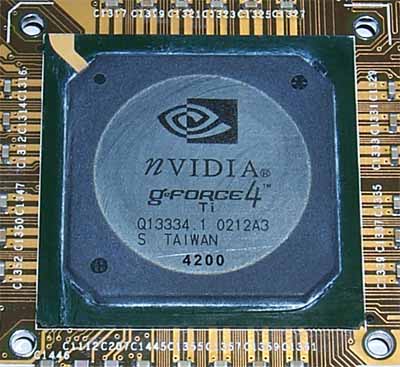
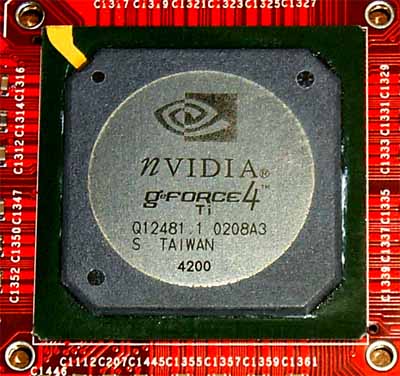
All the cards have a Philips 7108 chip, but it doesn't mean
VIVO support (Video-In Video-Out) in all cases. In particular, the Gainward and
Palit cards use this codec only for a TV-out. Unfortunately, we received the ABIT
card in the OEM package, that is why it didn't have a respective adapter-splitter
with it.
Now let's take a gander at the accessories:
| ABIT Siluro GF4 Ti 4200 64 MBytes |
| User manual, CD with drivers and utilities, DVI-to-VGA adapter,
adapter-splitter for VIVO, S-Video extender. |
- |
| Prolink PixelView GeForce4 Ti 4200 128 MBytes |
| User manual, CD with drivers and utilities, CD with Ballistics
and Venom games, WinDVD, PowerDirector 2.0ME (for VIVO), DVI-to-VGA adapter, adapter-splitter
for VIVO, S-Video extender. |
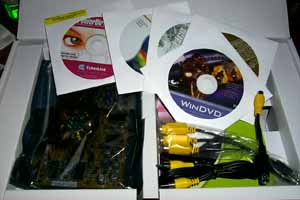
|
| Palit Daytona GeForce4 Ti 4200 128 MBytes |
| Although the card ships in a package, a set of accessories is
very scanty, that is why we can consider it an OEM one. No adapters are provided. |
- |
| Gainward Powerpack Ultra/650 XP 64 MBytes |
| This card ships in an OEM package, but it has come with a user
manual, a CD with drivers and an S-Video-to-RCA adapter. |
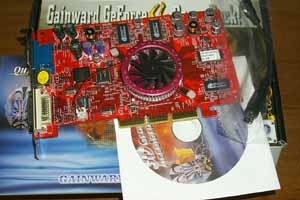
|
Three cards (except Gainward) ship in the retail packages, but in our case the
ABIT solution was received in an OEM one, and the Gainward's model has an original
OEM package.
| Prolink PixelView GeForce4 Ti 4200 128 MBytes |
| The package is quite big, the design and the contents are very
attractive. |
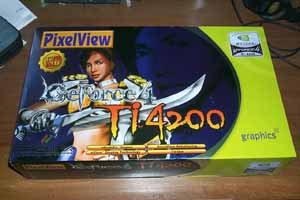
|
| Palit Daytona GeForce4 Ti 4200 128 MBytes |
| The box looks like a chess board, which is typical of Palit. |
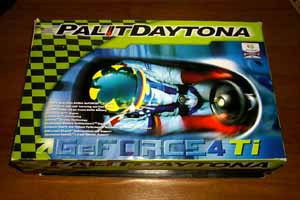
|
| Gainward Powerpack Ultra/650 XP 64 MBytes |
| Gainward uses an interesting method to distinguish the Retail
and OEM packages: they differ not only in a set of accessories but also in a box
size. It's well seen on the previous photo that this card has very small dimensions. |
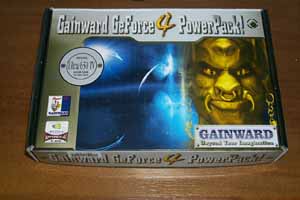
|
That's all we have to say about peculiarities of the cards in question.
Overclocking
| ABIT Siluro GF4 Ti 4200 64 MBytes |
250/513 -> 310/610 MHz, a very good potential of the card. |
| Prolink PixelView GeForce4 Ti 4200 128 MBytes |
250/460 -> 310/560 MHz, a very good potential of the core, and
the Samsung's memory shows good results for 4ns. |
| Palit Daytona GeForce4 Ti 4200 128 MBytes |
250/530 -> 316/566 MHz: the core's overclocking is impressive,
and again the Samsung's memory shows good results for 4ns. |
| Gainward Powerpack Ultra/650 XP 64 MBytes |
250/513 -> 310/580 MHz, despite the 3.5ns memory the overclocking
is quite bad because of the memory. |
The overclocking results mean that it's quite easy to turn
all the cards into Ti 4400, and some are coming very close to the Ti 4600. Besides,
the chips easily exceed 300 MHz.
Note:
- in course of overclocking you must provide additional cooling, in particular,
for the card (first of all, for its memory):

- overclocking depends on a definite sample, and you shouldn't generalize the
results of one card to all video cards of this mark or series. The overclocking
results are not the obligatory characteristics of a video card.
Test system and drivers
Taking into account that we have already studied all peculiarities
of operation of the NVIDIA GeForce4 Ti 4200/4400/4600, there is no need to repeat
them again. Besides, our 3Digest
widely covers performance of such cards in comparison with many others. That is
why I recommend that you go to the above review, and later I will give you definite
links.
Testbeds:
- Pentium 4 2200 MHz based computer:
- Intel Pentium 4 2200 (L2=512K);
- ASUS P4T-E (i850);
- 512 MBytes RDRAM PC800;
- Quantum FB AS 20 GBytes;
- Windows XP.
- Athlon XP 1666 MHz (2000+) based computer:
- AMD Athlon XP 2000+
- EPoX 8KHA+ (VIA KT266A);
- 512 MBytes DDR SDRAM PC2100;
- Fujutsu 20 GBytes;
- Windows XP.
The test system was coupled with ViewSonic P810 (21") and ViewSonic
P817 (21") monitors.
In the tests we used NVIDIA's drivers of v29.20. VSync was
off, S3TC was off.
Test results
Before we start examining 2D quality I should say that there
is no a complete technique of objective estimation of this parameter because:
- Almost all modern 3D accelerators can have 2D quality much dependent on a
certain sample, and it's impossible to trace all cards;
- 2D quality depends not only on a video card, but also on a monitor and a
cable;
- Besides, certain monitors do not get along with certain video cards.
As for the tested samples, together with the ViewSonic P817
monitor and BNC Bargo cable the cards showed excellent quality at the
following resolutions and frequencies:
| ABIT Siluro GF4 Ti 4200 64 MBytes |
1600x1200x75 Hz, 1280x1024x85 Hz, 1024x768x100 Hz |
| Prolink PixelView GeForce4 Ti 4200 128 MBytes |
1600x1200x85 Hz, 1280x1024x85 Hz, 1024x768x100 Hz |
| Palit Daytona GeForce4 Ti 4200 128 MBytes |
1600x1200x85 Hz, 1280x1024x100 Hz, 1024x768x120 Hz |
| Gainward Powerpack Ultra/650 XP 64 MBytes |
1600x1200x85 Hz, 1280x1024x100 Hz, 1024x768x120 Hz |
For estimation of 3D performance we used:
- Return to Castle Wolfenstein (MultiPlayer) (id Software/Activision) - OpenGL,
multitexturing, Checkpoint-demo,
test settings - maximum, S3TC OFF, the configurations can be downloaded
from here
Test order: enable the console with the '~' button and type:
timedemo 1 (press Enter)
demo checkpoint (press Enter)
- 3DMark2001 SE Pro (MadOnion/Remedy), Game2 "Dragothic" - DirectX 8.0, Hardware
TCL, multitexturing, LOW Details, DXTC OFF, double buffering, 24-bit Z-buffer
Test order:
through the 3DMark2001 menu of settings using the Batch
mode
- Serious Sam: The Second Encounter v.1.05 (Croteam/GodGames) - OpenGL, multitexturing,
Grand Cathedral demo, test settings: quality, S3TC OFF
Test order: enable the console with the '~' button and type:
dem_bProfile=1 (press Enter)
start up Grand Cathedral demo from the menu
- Quake3 Arena v.1.17 (id Software/Activision) - OpenGL, multitexturing, Quaver,
test settings are maximum: detail level - High, texture detailing level - #4,
S3TC OFF, smoothness of curved surfaces is greatly increased with variables
r_subdivisions "1" and r_lodCurveError "30000" (at default r_lodCurveError
is 250 !), the configurations can be downloaded from here
- 3DMark2001 Pro (MadOnion/Remedy) - DirectX 8.0, Hardware TCL, Game1, Game2,
Game3, Game4, Low, High detail levels
- Comanche4 Benchmark Demo (NovaLogic) - Direct3D, Shaders, Hardware T&L,
Dot3, cube texturing, highest quality
Test order: start up the game the following way:
c4demo.exe /advbench fps.txt 1024 32 noaudio nct dx7
(press Enter)
- RightMark Video Analyzer v.0.3.2 (Philip
Gerasimov) - DirectX 8.1, Dot3, cube texturing, shadow buffers, vertex and
pixel shaders (1.1, 1.4).
test settings: pixel shaders 1.1, shadow buffers OFF.
The overclocked cards are marked with red color, the sign
o/c (overclocked) is followed by the frequencies reached.
- 1. Return to Castle Wolfenstein - maximum quality settings
- 2. Quake3, QUAVER, - maximum settings
- 3. Comanche4
- 4. 3DMark2001, Game2 Low Details (Dragothic)
- Windows
ME
- Tests
on Athlon XP 2000+ (1666 MHz), 1024x768
- Tests
on Athlon XP 2000+ (1666 MHz), 1280x1024
- Tests
on Athlon XP 2000+ (1666 MHz), 1600x1200
- Tests
on Pentium 4 2200 MHz, 1024x768
- Tests
on Pentium 4 2200 MHz, 1280x1024
- Tests
on Pentium 4 2200 MHz, 1600x1200
- Tests
on Pentium 4 2200 MHz, 800x600, Anti-aliasing
- Tests
on Pentium 4 2200 MHz, 1024x768, Anti-aliasing
- Tests
on Pentium 4 2200 MHz, 1280x1024, Anti-aliasing
- Windows
XP
- Tests
on Athlon XP 2000+ (1666 MHz), 1024x768
- Tests
on Athlon XP 2000+ (1666 MHz), 1280x1024
- Tests
on Athlon XP 2000+ (1666 MHz), 1600x1200
- Tests
on Athlon XP 2000+ (1666 MHz), 800x600, Anti-aliasing
- Tests
on Athlon XP 2000+ (1666 MHz), 1024x768, Anti-aliasing
- Tests
on Athlon XP 2000+ (1666 MHz), 1280x1024, Anti-aliasing
- Tests
on Pentium 4 2200 MHz, 1024x768
- Tests
on Pentium 4 2200 MHz, 1280x1024
- Tests
on Pentium 4 2200 MHz, 1600x1200
- 5. Serious Sam: The Second Encounter
- Windows
ME
- Tests
on Athlon XP 2000+ (1666 MHz), 1024x768
- Tests
on Athlon XP 2000+ (1666 MHz), 1280x1024
- Tests
on Athlon XP 2000+ (1666 MHz), 1600x1200
- Tests
on Pentium 4 2200 MHz, 1024x768
- Tests
on Pentium 4 2200 MHz, 1280x1024
- Tests
on Pentium 4 2200 MHz, 1600x1200
- Tests
on Pentium 4 2200 MHz, 800x600, Anti-aliasing
- Tests
on Pentium 4 2200 MHz, 1024x768, Anti-aliasing
- Tests
on Pentium 4 2200 MHz, 1280x1024, Anti-aliasing
- Windows
XP
- Tests
on Athlon XP 2000+ (1666 MHz), 1024x768
- Tests
on Athlon XP 2000+ (1666 MHz), 1280x1024
- Tests
on Athlon XP 2000+ (1666 MHz), 1600x1200
- Tests
on Athlon XP 2000+ (1666 MHz), 800x600, Anti-aliasing
- Tests
on Athlon XP 2000+ (1666 MHz), 1024x768, Anti-aliasing
- Tests
on Athlon XP 2000+ (1666 MHz), 1280x1024, Anti-aliasing
- Tests
on Pentium 4 2200 MHz, 1024x768
- Tests
on Pentium 4 2200 MHz, 1280x1024
- Tests
on Pentium 4 2200 MHz, 1600x1200
- 6. iXBT RightMark Video Analyzer
Conclusion
Well, all the cards are based on the reference design, but
at the same time each card has its own peculiarities.
- The Palit's card has an excellent price/speed ratio, besides it works at
the increased frequencies (I haven't seen yet 128 MBytes cards based on the Ti
4200 with memory frequencies higher than those of the 64 MBytes analog solutions
(except a SE version of SUMA).
- The Prolink is a brilliant solution as well, especially taking into account
a normal VIVO and games coming with the card (if it has a price so low as the
Palit's model, it will be the best choice).
- This version of Gainward (earlier we examined a 128 MBytes card) is more
modest; it just has traditionally high quality; and I wish the prices were comparable
to those of its competitors. Note that the card comes with an S-Video-to-RCA adapter
(though it is only an OEM package).
- The ABIT's card is of really high quality, supports VIVO, and is, as usual,
inexpensive.
In our 3Digest
you can find complete comparison characteristics of video cards of this and other
classes.
Highs:
- Excellent performance in 3D games;
- High quality of the tested samples;
- Some cards work at increased frequencies, but at the same time they do follow
the reference design;
- Original color of the Palit Daytona GeForce4 Ti 4200 128 MBytes, and the
company's name is at last written on the cooler, which now distinguishes such
cards from noname one;
- Excellent set of accessories of the Prolink PixelView GeForce4 Ti 4200 128
MBytes;
- All cards have a TV-out, and the Prolink and ABIT models have also a VIVO;
- The ABIT, Gainward and Prolink cards have all necessary adapters.
Lows:
- Scarce set of accessories of the Palit card;
- Worse 2D quality of the ABIT card (refers to the given sample).
Write a comment below. No registration needed!
|
|
 |
|
|
|




